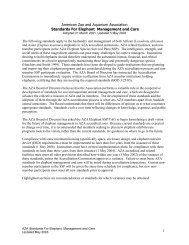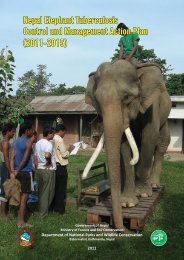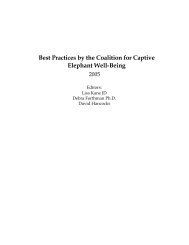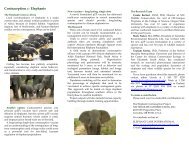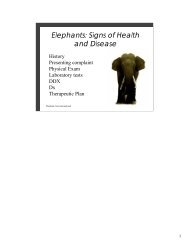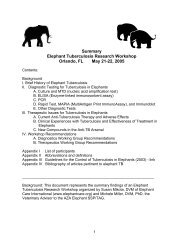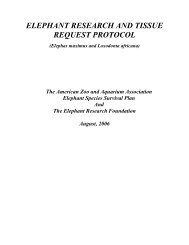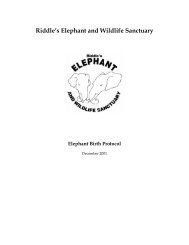Elephants Elephants - Wildpro - Twycross Zoo
Elephants Elephants - Wildpro - Twycross Zoo
Elephants Elephants - Wildpro - Twycross Zoo
- No tags were found...
Create successful ePaper yourself
Turn your PDF publications into a flip-book with our unique Google optimized e-Paper software.
when his residency within the herd is no longer being tolerated, typicallyduring adolescence and be put in protected contact from a certain age. Thiswill vary with individuals; it can be as young as three or as old as eight ornine. From the age of four regular updates of a bull’s profile notes and a sixmonthly review MUST take place in combination with a risk assessment asthe character of individual bulls will largely determine how they can bemanaged.A bull during musth may show behaviour that makes him difficult to manageso zoos should be prepared to house difficult bulls. To that end, all bullsMUST be maintained in such a way that at the very least they can beseparated from females and other males. However, it is not acceptable to keepbulls in physical and social isolation until required for breeding 1 .All collections keeping bulls MUST have the facility to carry out any essentialveterinary procedure in such a way that is safe for all staff and the elephantconcerned 2 .In the long term the zoo community needs to address the issue of captiveelephant bulls and the likely overall increase in number since this willseriously compromise the conservation breeding performance of zoos bytaking up valuable accommodation. The way forward may well be to explorethe feasibility of keeping bulls in bachelor herds in zoos capable of providingenough space. At this moment in time, the feasibility of such an approach hasnot been fully tested, but should be considered. All collections keeping bullsMUST ensure that staff are adequately trained (see Section 3.8).CALVESIt is important that calves are brought up in a matriarchal group. Calves havea long learning period and socialisation with other elephants is crucial. Effortsshould therefore be made to integrate hand-reared animals back to the groupas soon as possible. Females need to learn calf care, and the presence of ayoung animal in the group benefits all members.NOCTURNAL BEHAVIOUR<strong>Elephants</strong> continue to be active after the public and keeping staff have left.Research has shown that elephants are most active between 1800 and 2400 and0600 and 0700, exhibiting the normal social repertoire, social interactions andfeeding behaviour. In general, observations show that animals are active formore than 50% of the ‘nocturnal’ period (Brockett et al 1999) (Weisz et al 2000).These observations, hardly surprisingly, demonstrate that captive elephantsare active for around the same period in captivity as in the wild (i.e. sleepingfor a maximum of five hours in 24). Thus zoos MUST strive to keep animalsin unrestricted social groupings at night and provided with sufficient1 Section on bull management has been clarified.2 In the UK only WWAP currently has a chute. It cost approximately 15K GBP and was copiedfrom the one in Burnet Park. It is a squeeze with one movable wall.40




